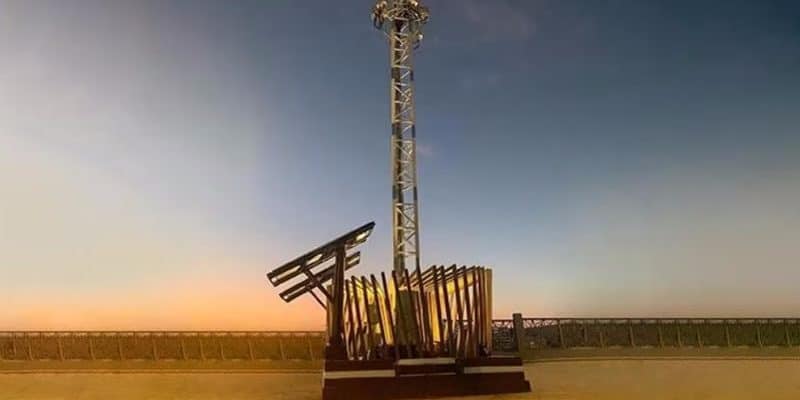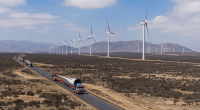As COP28 approaches, underlining the global climate emergency, Egypt is taking an important step towards reducing the environmental impact of network towers. Since January 2023, Telecom Egypt has been operating a tower made from materials that are both environmentally friendly and aesthetically pleasing, while being supported by integrated wireless connection solutions and a solar energy system. This marks a significant step forward in the quest for sustainable connectivity in Africa.
The headlong rush to ubiquitous connectivity and the advent of the Internet of Things (IoT) underline the urgent need for a green transition in the digital sector, particularly in Africa. On the continent, the explosion in demand for connectivity, coupled with the growing adoption of smartphones in sub-Saharan Africa, calls for an innovative solution to reduce the energy consumption of network towers. In 2020, these infrastructures produced 330 million tonnes of CO2, or no less than 0.9% of the world’s energy-related greenhouse gas emissions, according to the International Energy Agency (IEA).
Against this backdrop, Egypt is setting itself apart by deploying the continent’s first green tower compatible with the wireless network. Thanks to a partnership with Huawei, Telecom Egypt commissioned an 18-metre fibre-reinforced polymer tower on 12 January 2023, paving the way for a more sustainable digital future in Africa.
The new network tower in Egypt, made from fibre-reinforced polymer, stands out for its eco-friendly design, as this material, which is lighter and stronger than traditional constructions, contributes to a significant reduction in energy consumption and the carbon footprint associated with telecoms infrastructure.
A more sustainable alternative to steel
Highly resistant to wind and high temperatures, this composite material replaces the steel that forms the structure of most network towers operating in Egypt. “Recent studies show that FRP poles produce 43% fewer carbon dioxide (CO2) emissions than steel, and also reduce end-to-end energy consumption by almost half during manufacturing and shipping,” explains Jim Liu, CEO of Huawei Egypt.
The carbon footprint of steel towers is primarily linked to manufacturing, which requires a significant amount of energy. The global steel industry is the source of between 7% and 9% of man-made emissions worldwide, with 2.6 billion tonnes of CO2 sent into the atmosphere in 2020, according to the World Steel Association. The carbon footprint of the aluminium used in the construction of certain network towers is also significant: 11.7 tonnes of CO2 for each tonne of aluminium produced, compared with 1.83 million tonnes of CO2 for steel.
The lifespan of FRP?
Another significant advance is that the manufacture of FRP towers “requires much less heat than the manufacture of aluminium and steel, which reduces the amount of water needed for cooling”, explains researcher Mary Chase. The FRP tower, whose main component is fibreglass produced from sand, benefits from a reinforced structure thanks to this light, durable material. “Fibreglass is extremely light, so a cement base is not necessary. Instead, the composite tower is anchored using a durable, fast-curing polyurethane foam,” explains the Portland-based researcher.
To date, the lifespan of fibre-reinforced polymer network towers is estimated at between 20 and 25 years, compared with 15 and 30 years for steel structures, “depending on variables such as local weather conditions and the quality of the tower’s construction and finish“, explains Mary Chase.
Energy efficiency and the use of solar energy
In Egypt, the new network tower developed by Huawei and its partner Telecom Egypt supports wireless network antennas and radio units equipped with energy-saving technologies. The equipment is powered in part by a 2-kilowatt photovoltaic solar system, “resulting in a further 20% reduction in CO2 emissions”, says Jim Liu, CEO of Huawei Egypt. The equipment supplied by the ICT giant saves 40% of energy compared with conventional network towers.
Finally, this new network tower is “based on passive cooling, which eliminates the need for air conditioning and results in a 47% reduction in energy consumption compared with sites with equipment rooms”, explains the director of Huawei Egypt.
Huawei plans to duplicate this innovation in Africa. The global technology giant is investigating different loading conditions for equipment such as antennas and remote radio units (RRUs) on the fibre-reinforced polymer (FRP) tower. The aim of the evaluation is to ensure that the FRP tower can accommodate the different scenarios and requirements of wireless network installations in different African countries. The evaluation could lead to the installation of FRP towers on rooftop sites, although this will require consideration of the forces, reactions and weights of this type of telecommunications antenna.
This innovation represents a major milestone in the quest for more sustainable connectivity in Africa, a continent in the throes of digital transformation. Huawei, in collaboration with Telecom Egypt, is demonstrating its commitment to green solutions, helping to shape a greener future for telecommunications. In the midst of the rising climate crisis, Huawei’s contribution takes on paramount importance, offering a model of sustainable development that could inspire other initiatives across the continent and beyond, on the eve of COP28.
Article produced in partnership with Huawei






